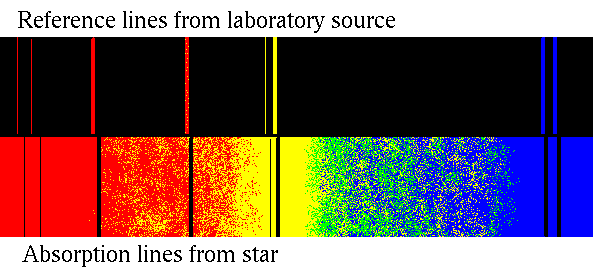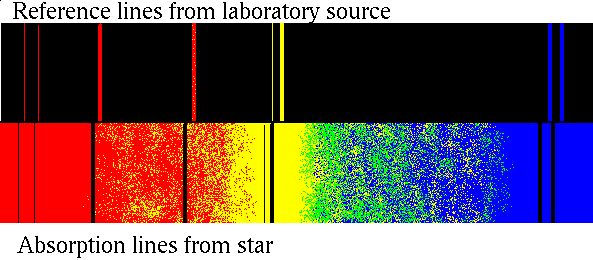Wavelength shift for moving objects.
The wavelength of light emitted by a moving object is shifted.
This effect is called the doppler shift.
- If the object is coming toward you, the light is shifted toward
shorter wavelengths, blue shifted.
- If the object is going away from you, the light is shifted toward
longer wavelengths, red shifted.
- The amount of shift is bigger if the emitting object is moving faster.
We don't normally notice this for light. But it is easy to observe for
sound:
- Blue shifted = higher frequency = higher pitch.
- Red shifted = lower frequency = lower pitch.
The reason for this effect is easiest to understand from a picture.
The object emits one wave per second. At successive one second times it
was located at the positions of the blue dots ...

To get it really right, you should understand the Special Theory of
Relativity, but the picture gives the qualitative idea.
Use of the Doppler shift in astronomy
Here is what the spectrum of a star that is moving toward us might
look like (somewhat simplified):

Here is what the spectrum of a star that is moving away from us might
look like (somewhat simplified):

- The amount of shift is bigger if the emitting object is moving faster.
- Thus if we know the original wavelength, we can deduce the speed.
- For a spectral line from an element that we can identify,
we do know the wavelength.
- Thus for many astronomical objects we can tell
- Is it coming toward us?
- Is it going away?
- If so, how fast is it moving toward us or away from us?
- But note that this method does not tell us how fast it is
moving sideways.

Davison E. Soper, Institute of Theoretical Science,
University of Oregon, Eugene OR 97403 USA
soper@bovine.uoregon.edu




